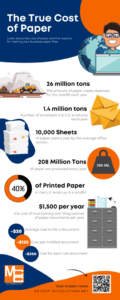
When deciding whether to upgrade your printers and copiers, several things are considered. The cost of the equipment, the cost of maintenance and supplies, and the number of devices needed all factor into the decision to purchase or upgrade your printing fleet. But what about the effect on the environment? From the amount of energy used to run the device to the amount of paper used by the employees, many things get overlooked when a business purchases new copiers or printers.
When the electronic boom started to take off, there were suspicions that paper consumption and the need for copiers and printers would drastically decrease. In the last 20 years, the usage of paper products has increased from 92 million tons to 208 million tons. We may carry our documents with us on tablets and phones, but we have not stopped printing. There will always be a need for printers and copiers, but luckily, there is a way to keep our paper copies in a more environmentally friendly way.

Evaluate
The first step in a more environmentally friendly printing office is to evaluate your current printing methods and usage. Look around your office. Does every employee have a printer on their desk? Is there more than 1 copier in your area? Does your office track print usage or enforce printing quotas?
Understanding your printing needs and usage will help you find areas of waste. Is that one employee printing a paper copy of every email for their archives? Learning where your environmental drains are located and what they are will make fixing the problem easier in the future. Software, such as Papercut, helps you track who is printing what to where and allows you to control waste. The software even shows you the power consumption of your devices and the effect your printing is having on the environment.
Research
Once you have figured out how much paper you are wasting and how much less energy efficient your older or excessive amount of printers are, you can begin researching new equipment. Most copiers and printers these days are Energy Star compliant, but there is more to it than that. There is a difference between inkjet and dry toner printers. Learning what is available and which options will be most efficient before purchasing will be beneficial.
Track
Once you decide how many and which type of devices to purchase, tracking your employee’s printing is essential to reducing the amount of toner and paper waste in your office. Software, such as Papercut, helps you track who is printing what to where and allows you to control waste. The software even shows you the power consumption of your devices and the effect your printing is having on the environment. Not only will this help reduce the amount of needless printing, but it will also show you which users might need more training on how to properly use the new devices to cut down on erroneous printing.
Train
Properly training your employees on how to use your new copiers and printers is a major factor in reducing waste. Understanding what the functions of the copiers and print drivers do helps employees avoid repeatedly printing or copying a document because they failed to hit the correct buttons the first time. Many manufacturers offer online training videos, and MCC personally trains staff members after every new sale. If you need more training, give your salesperson a call and arrange a time for them to come back out and retrain your staff or train new employees who were not available the first time.
Recycle
Create an office-wide recycling program to reduce your paper waste further. Place recycle boxes next to each copier or MFP so that unneeded paper can be recycled. This makes it easy for your staff to comply and gives a central location for the recycling. Most cities now participate in a recycling program that can collect your paper waste and further reduce your carbon footprint.
Following these 5 easy steps will help you not only reduce your impact on the environment but will save you money on equipment costs, toner, and paper supply costs, and possibly increase the efficiency of properly trained employees.
For more information on how MCC can help, visit our Document Solutions page and request a consultation.



